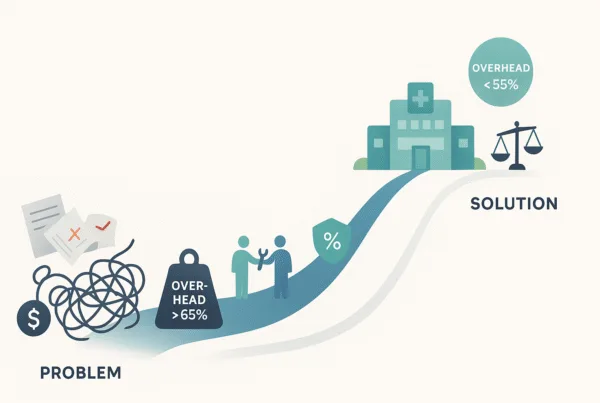
If you’re a medical practice owner exploring the possibility of a sale, one of your first questions is likely, “How does my specialty affect what my practice is worth?” It’s a critical question because in healthcare M&A, not all specialties are valued equally. Buyers apply different risk profiles, growth assumptions, and strategic priorities to each vertical.
While your practice’s core financials provide the foundation, your specialty sets the stage for what buyers are willing to pay. As we discussed in our complete guide to healthcare practice valuation, the final number is a product of both your financials and the market’s perception of your specialty. This guide provides a focused look at the current valuation multiples for mid-sized local medical practices, giving you the data-driven benchmarks you need.
The Foundation: Why EBITDA Multiples Matter Most
Before we get to the numbers, it is useful to have a quick refresher on the key metric. In healthcare M&A, value is almost always expressed as a multiple of Adjusted EBITDA (Earnings Before Interest, Taxes, Depreciation, and Amortization). This figure represents your practice’s true, normalized cash flow.
A valuation multiple is a straightforward way to express a buyer’s confidence in the stability and future growth of that cash flow. A higher multiple means buyers a see lower risk and greater upside. For a full breakdown of how this crucial metric is calculated, see our guide, EBITDA Explained for Physicians.
2025 Valuation Multiples by Medical Specialty
Based on current market data and transaction analysis, the following table outlines the average EBITDA multiple ranges for several key medical specialties. These figures reflect the market for stable, mid-sized local practices and serve as a strong starting point for any valuation discussion.
| Medical Specialty | Average EBITDA Multiple (2025) | Key Drivers & Commentary |
|---|---|---|
| Plastic Surgery | 8.5x – 8.8x | Commands premium multiples due to high cash-pay margins but shows more volatility during economic uncertainty. |
| Oncology | 8.0x – 8.5x | A highly sought-after specialty with a strong reimbursement outlook, demographic tailwinds, and high strategic value. |
| Behavioral Health | 8.0x – 8.2x | Experiences intense buyer interest from both PE and strategic acquirers due to rising demand and stable reimbursement. |
| Urgent Care | 7.5x – 8.0x | Functions as a crucial “front door” for larger health systems, driving high transaction activity and strong valuations. |
| Ambulatory Surgery Centers (ASCs) | 7.0x – 8.0x | The ongoing shift of procedures from inpatient to outpatient settings fuels robust and sustained buyer demand. |
| Primary Care | 7.0x – 7.5x | Viewed as a stable, essential service and a foundational platform for patient acquisition and value-based care models. |
| Diagnostic Imaging & Laboratories | 7.0x – 7.5x | These are essential outpatient services with predictable, recurring revenue streams that buyers find attractive. |
These numbers show a clear hierarchy. Buyers are willing to pay a premium for specialties with strong growth tailwinds and defensible profit margins, such as oncology and behavioral health. Stable, essential services like primary care form the bedrock of the market, offering resilience and strategic value.
What Drives a Multiple to the High End of the Range?
Your specialty provides a valuation baseline, but several other factors determine whether your practice will be valued at the low, middle, or high end of that range. Sophisticated buyers look past the label and analyze the underlying strengths of the business.
-
Essential vs. Elective Care: Practices focused on essential, non-discretionary care (e.g., primary care, oncology, behavioral health) have proven more resilient to economic headwinds. While high-margin elective specialties like plastic surgery can achieve top-tier multiples, their revenue is often more volatile, a factor buyers weigh carefully.
-
The Power of Scale: A practice generating $2M in EBITDA will almost always receive a higher multiple than a similar practice in the same specialty generating $750K. Scale reduces perceived risk and makes the practice a more attractive “platform” for future growth, especially for buyers pursuing consolidation and roll-up strategies.
-
Ancillary Services & Payer Mix: A practice that has successfully integrated profitable ancillary services proves its ability to innovate and expand revenue streams. Likewise, a healthy payer mix with strong commercial contracts signals a more sustainable and profitable revenue base than one heavily reliant on government payers.
-
Strategic Demand: Some specialties are “hot” due to broader market trends. Right now, the focus on mental healthcare and the push toward value-based care models makes behavioral health and certain primary care platforms exceptionally attractive to buyers, often boosting their multiples.
Applying the Right Multiple is More Art Than Science
HGaving a table of multiples is a great start, but it’s just that—a start. A generic multiple from a list cannot capture your practice’s unique growth story, the strength of your clinical team, or your specific position in the local market.
Sophisticated buyers do not simply apply an industry-average number to your EBITDA. They build a detailed financial model to project future performance. To get the best outcome, you need to approach the process with the same level of rigor.
This is where expert guidance becomes invaluable. The difference between an average outcome and a premium one often comes down to how your practice’s story is told. An advisor helps frame the narrative, build a defensible financial model, and create a competitive process among qualified buyers. This is a core component of how we help clients with their practice value enhancement strategies.
Knowing your benchmark multiple is one thing. Having a partner who can build the case for why you deserve a number at the top of that range—or even above it—is another. Our team of medical practice valuation experts specializes in this process, ensuring you present your practice in the best possible light.
From Benchmark to Reality
Your medical specialty establishes a likely valuation corridor. But the specific factors of your practice—its size, operational efficiency, growth trajectory, and strategic positioning—are what determine your final destination.
Use these 2025 multiples as a guidepost to understand where you stand in the current market. The next step is to get a precise, defensible valuation that reflects the unique attributes of the business you have worked so hard to build.
Ready to find out where your practice truly falls within these ranges? Contact SovDoc today for a confidential, no-obligation valuation consultation and position your practice for maximum value.
Frequently Asked Questions
How does the medical specialty affect the valuation multiples of a medical practice?
In healthcare M&A, different medical specialties are valued with distinct EBITDA multiples reflecting varying risk profiles, growth potentials, and strategic demands. For example, specialties like plastic surgery and oncology command higher multiples due to high margins and strong growth tailwinds, while primary care, considered a stable essential service, typically has lower multiples.
What is the importance of EBITDA multiples in valuing a medical practice?
EBITDA multiples represent a buyer’s confidence in the normalized cash flow of a practice, indicating its stability and future growth potential. A higher EBITDA multiple means lower perceived risk and higher expected returns, making it a critical metric in healthcare practice valuation.
Which specialties had the highest average EBITDA multiples according to the 2025 data?
According to 2025 data, plastic surgery commands the highest average EBITDA multiples ranging from 8.5x to 8.8x, followed closely by oncology at 8.0x to 8.5x. These specialties benefit from premium pricing drivers like high cash-pay margins and strong reimbursement outlooks.
What other factors besides specialty influence whether a medical practice’s valuation multiple reaches the high end of its range?
Beyond specialty, factors include the practice’s scale (larger EBITDA typically yields higher multiples), integration of profitable ancillary services, the payer mix favoring strong commercial contracts, economic resilience of the focus area (essential vs. elective care), and strategic market demand driven by trends such as mental health and value-based care.
Why is expert guidance important when selling a medical specialty practice?
Expert guidance is crucial because applying a generic industry multiple does not reflect a practice’s unique strengths and growth story. Advisors help craft a compelling narrative, build defensible financial models, and create competitive bidding among buyers, all of which help achieve premium valuation outcomes beyond average market multiples.



